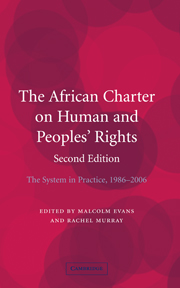Book contents
- Frontmatter
- Contents
- List of contributors
- Table of cases
- List of abbreviations
- Editors' Preface
- Introductory Preface: The African Charter and African Commission on Human and Peoples' Rights
- 1 The African Union and the Regional Human Rights System
- 2 The State Reporting Mechanism of the African Charter
- 3 Communications under the African Charter: Procedure and Admissibility
- 4 Evidence and Fact-Finding by the African Commission
- 5 Civil and Political Rights in the African Charter on Human and Peoples' Rights: Articles 1–7
- 6 Civil and Political Rights in the African Charter: Articles 8–14
- 7 Group Rights
- 8 The Role of Non-governmental Organisations and National Human Rights Institutions at the African Commission
- 9 A View from the Inside: The Role of the Secretariat
- 10 The Special Rapporteurs in the African System
- 11 Working Groups of the African Commission and their Role in the Development of the African Charter on Human and Peoples' Rights
- 12 The Creation of a New African Court of Justice and Human Rights
- 13 Protocol to the African Charter on the Rights of Women in Africa
- Bibliography
- Index
3 - Communications under the African Charter: Procedure and Admissibility
Published online by Cambridge University Press: 01 July 2009
- Frontmatter
- Contents
- List of contributors
- Table of cases
- List of abbreviations
- Editors' Preface
- Introductory Preface: The African Charter and African Commission on Human and Peoples' Rights
- 1 The African Union and the Regional Human Rights System
- 2 The State Reporting Mechanism of the African Charter
- 3 Communications under the African Charter: Procedure and Admissibility
- 4 Evidence and Fact-Finding by the African Commission
- 5 Civil and Political Rights in the African Charter on Human and Peoples' Rights: Articles 1–7
- 6 Civil and Political Rights in the African Charter: Articles 8–14
- 7 Group Rights
- 8 The Role of Non-governmental Organisations and National Human Rights Institutions at the African Commission
- 9 A View from the Inside: The Role of the Secretariat
- 10 The Special Rapporteurs in the African System
- 11 Working Groups of the African Commission and their Role in the Development of the African Charter on Human and Peoples' Rights
- 12 The Creation of a New African Court of Justice and Human Rights
- 13 Protocol to the African Charter on the Rights of Women in Africa
- Bibliography
- Index
Summary
Introduction and overview of the individual communications procedure
The African Charter's protective ambit (or ‘communications procedure’) comprises two main procedures: the inter-State and individual ‘communications’ (or complaints) procedures. So far, the African Commission has dealt almost exclusively with individual communications, the first inter-State communication being published in July 2006 as part of its Twentieth Activity Report. The discussion that follows briefly sets out the individual communications procedure, with an emphasis on the admissibility phase. Although it has been of less practical importance, the inter-State procedure is also briefly touched upon.
The African Court on Human and Peoples' Rights was established to ‘complement’ the protective mandate of the African Commission, and came into being in 2006 when its first eleven members were elected and its seat assigned. The role of the Court in the individual and inter-State procedure is also considered, even though its practice has not yet clearly crystallised.
The Commission was established as a quasi-judicial body but without an explicit mandate to consider individual communications. Its competence to consider individual communications has, however, been institutionalised without much resistance, and over time its procedure has become increasingly judicialised. This trend is exemplified by the increasingly detailed nature of its findings and reasoning, the issuing of remedial orders in cases of violations, the adoption of minority views, and the decline in recourse to friendly settlements.
- Type
- Chapter
- Information
- The African Charter on Human and Peoples' RightsThe System in Practice 1986–2006, pp. 76 - 138Publisher: Cambridge University PressPrint publication year: 2008

